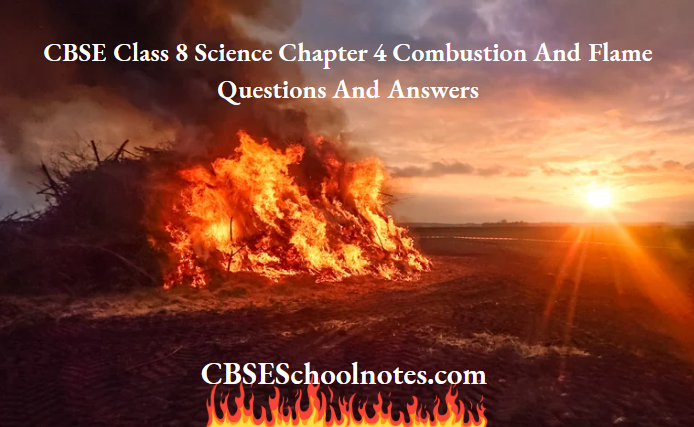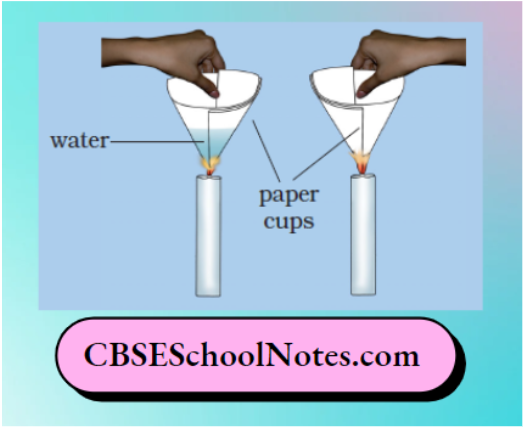CBSE Class 8 Science Chapter 4 Combustion and Flame worksheet With Answers Fill In The Blanks
Question 1. A __________ process in which a substance reacts with _____ to give off heat is called combustion.
Answer: chemical, oxygen
Question 2. When the clothes of a person catch __________, the person is covered with a __________ to extinguish the fire.
Answer: Fire, blanket
Read And Learn More CBSE Class 8 Science Question And Answers
Question 3. The substances that give very __________ ignition temperatures and can easily catch fire with a flame are called __________ substances.
Answer: Low, inflammable
Question 4. The substances which vaporise during _____________ given flame.
Answer: Burning
Question 5. Wood, paper, and CNG are substances.
Answer: Combustible
Question 6. Burning of wood and coal causes _______ of air.
Answer: Pollution
Question 7. A liquid fuel used in homes is ________.
Answer: Kerosene
question 8. Fuel must be heated to its _______ before it starts burning.
Answer: Ignition temperature
Question 9. Fire produced by oil cannot be controlled by ________.
Answer: Water
Question 10. ___________ fuel is cheap, readily available, and causes less
Answer: Ideal
Question 11. ___________ gas is a promoter of combustion
Answer: Oxygen

CBSE Class 8 Science Chapter 4 Extra Questions And Answers For Exam Preparation: True or False
Question 1. Air is necessary for combustion.
Answer: True
Question 2. Magnesium is a non-combustible metal.
Answer: False, magnesium is a combustible metal.
Question 3. Carbon dioxide is an excellent fire extinguisher.
Answer: True
Question 4. Water is the best extinguisher for fires involving electrical equipment.
Answer: False, carbon dioxide is the best extinguisher for fires involving electrical equipment.
Question 5. The middle zone is the hottest zone of a flame.
Answer: False, the outer zone is the hottest zone of a flame.
Question 6. LPG fire is an inflammable substance.
Answer: True
Question 7. Spontaneous combustion takes place in the absence of external heat.
Answer: True

CBSE Class 8 Science Chapter 4 Combustion And Flame Match The Columns
Question 1. Match Column 1 with Column 2.

Answer: A—4, B—6, C—5, D—3, E—1, F—2
Question 2. Match the following for the flame of a candle

Answer: A-3—x, B-2—z, C-l—y
Question 8. Match Column 1 with Column 2.

Answer: A-3, B-1. C-4, D-2
CBSE Class 8 Science Chapter 4 Combustion and Flame
The following questions consist of two statements: Assertion (A) and Reason (R). Answer these questions by selecting the appropriate option given below.
- Both A and R are true, and R is the correct explanation of A
- Both A and R are true, but R is not the correct explanation of A
- A is true, but R is false
- A is false, but R is true
Question 9.
- Assertion (A): Electrical components can catch fire.
- Reason (R) Electrical fire can be extinguished using water.
Answer: 3. A is true, but R is false
Question 10.
- Assertion (A) A Candle can burn a block of wood.
- Reason (R) The Ignition temperature of wood is high.
Answer: 4. A is true, but R is false
The following questions consist of two statements. Assertion (A) and Reason (R). Answer the following questions by selecting the appropriate options given below.
- Both A and R are true, and R is the correct explanation of A.
- Both A and R are true, but R is not the correct explanation of A.
- A is true, but R is false.
- A is false, but R is true.
Question 1.
Assertion (A) Fireworks produce different colours.
Reason (R) Different chemicals are used in the fireworks to produce different colours.
Answer: 1. Both A and R are true, and R is the correct explanation of A.
Question 2.
Assertion (A) Spontaneous combustion can occur in materials like dry leaves.
Reason(R) Spontaneous combustion happens due to the presence of excess oxygen in materials.
Answer: 3. A is true, but R is false. R can be corrected as Spontaneous combustion occurs in materials that have a low ignition temperature. Through internal chemical reaction with oxygen, they release heat and burn on their own.
Question 3.
Assertion (A) LPG gas can catch fire easily.
Reason (R) LPG has a high ignition temperature.
Answer: 3. A is true, but R is false. R can be corrected as LPG has a low ignition temperature, so it catches fire easily.
Question 4.
Assertion (A) When a burning candle is covered with a glass jar, the flame goes out.
Reason (R) The glass jar prevents the flow of oxygen to the candle flame.
Answer: 1. Both A and R are true, and R is the correct explanation of A.








































